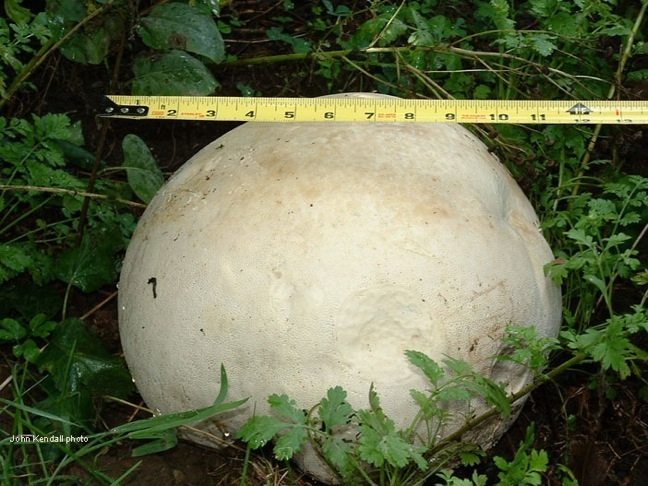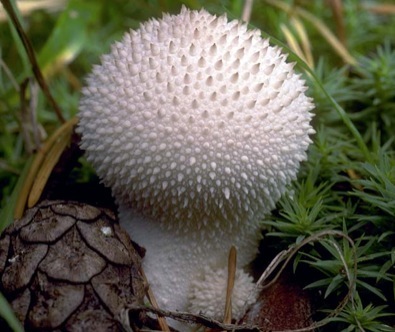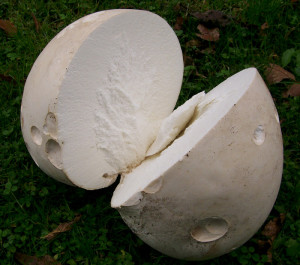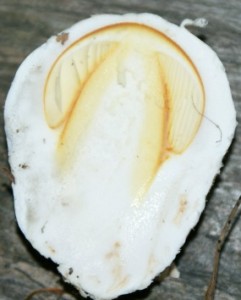
Giant puffball
Do not eat any mushroom without checking in person with a local, live, mushroom collector.
Lycoperdon perlatum: Edible Puffballs
I avoided mushrooms for a long time, and with good reasons. Some of them are on par with cyanide and arsenic and can melt your liver. Worse, unlike most plants that let you know within the hour you have erred, mushrooms can wait several days. So when I decided to learn about mushrooms I went with the classic first: The puffball, Lycoperdon perlatum (lye-ko-PAIR-don per-LAY-tum) also called the Common Puffball, the Gem-studded Puffball and the Devil’s Snuff Box.

Most of us learned about puffballs when were were kids, finding them in the spore stage and flattening them into a puff of spore smoke. Remember the brown cloud that used to spray out from under our foot? Then it will come to no surprise to you that the genus name is Lycoperdon, which plainly said means “wolf fart.” As for the species name, perlatum means pearl-like and the puffballs often in clumps like a bunch of pearls.
While perhaps the puffball is the least complicated mushroom to identify, there are things you must absolutely look for and here is the reason why. Two other mushrooms can resemble it, both fatal. The look alikes are young Sclerodermas and Amanitas.
Always cut your “puffball” from top to bottom and examine the inside. A young Sclerdomera will be round and white inside like a puffball but the white flesh will be hard. The white flesh of the puffball is marshmallow soft. The young Amanita can be round and white inside like a puffball but it will show the outline of the yet unopened mushroom. The Sclerdomera has caused deaths and the Amanita is nearly always fatal without medical attention and often fatal with medical attention. See photos below.
Never take for granted you have a puffball. Always cut each one open vertically, top to bottom, and make sure it is one solid soft white mass inside with no outline. You should make sure the inside is pure white, never dark, and that the outer skin of the puffball is thin. If the inside is dark from the start and the outer skin is thick you probably have Scleroderma, one of the earth balls.
With smaller puffballs you must make sure the entire fruiting body is homogeneous, consistently a texture of marshmallows. You should slice down the center of every puffball to make sure there is not a pre-formed mushroom inside. If so, it is likely to be an immature form of the death angels, Amanita bisporigera, Amanita virosa, and Amanita verna. They are all deadly. Do NOT eat them. In fact they are quite cruel. Feeling better after the first attack is the sign of impending death. Ninety percent of all mushroom fatalities involve Amanitas.
On the other hand, there are no poisonous puffballs, and most forms are edible when young. Though as with everything, some individuals are allergic to them. Giant puffballs, that can grow as big as a basketball, are not only edible but mighty difficult to mis-identify. They are edible as long as the flesh is white and soft.
Green Deane’s “Itemized” Plant Profile
IDENTIFICATION: Round or pear shaped mushroom up to 3.5 inches tall, tapered base. Outer surface is composed of conical spines and irregular-shaped whitish to cream-colored warts that become brownish with age. They eventually fall away leaving pits or net-like scars on the spore case beneath. The spore case is divided into an upper fertile portion (gleba) and a sterile, stalk-like base, tan to pale brown or grayish brown, darker in age, thin-walled, papery, gleba white and fleshy at first becoming olive-brown and powdery as spores mature. Base sterile, chambered, taking up about a third to one half of the fruiting body. Spores round, minutely warted, pale yellow (yellow-brown to olive-brown in mass.)
TIME OF YEAR: Nearly year round in warm climates, summer fall in northern climates.
ENVIRONMENT: Usually in groups, often in clusters on ground, sometimes on well-decayed wood, in forests or open areas.
METHOD OF PREPARATION: Edible when immature and entirely white inside and soft. Can be sauteed in butter or added to soups and stews. Cut every puffball vertically and check to see that there is no outline of a mushroom inside.




